Secondary Research Project: Tata Group's Global Business Strategies
VerifiedAdded on 2023/01/04
|13
|4762
|71
Report
AI Summary
This secondary research project analyzes the Tata Group's strategies in both domestic and foreign markets. The report explores the reasons behind Tata's success in India, including adherence to business principles, philanthropic initiatives, diversification, and effective management. It also investigates the factors contributing to Tata's failures in foreign markets, such as financial struggles, economic downturns, cultural differences, and challenges in integrating acquired businesses like Corus. The project further examines strategies that Tata could adopt to succeed in foreign markets, emphasizing the importance of business expansion, understanding local market dynamics, and adapting to competitive environments. The research includes an overview of the company, a comprehensive literature review, and a discussion of findings, providing insights into the conglomerate's global business performance.
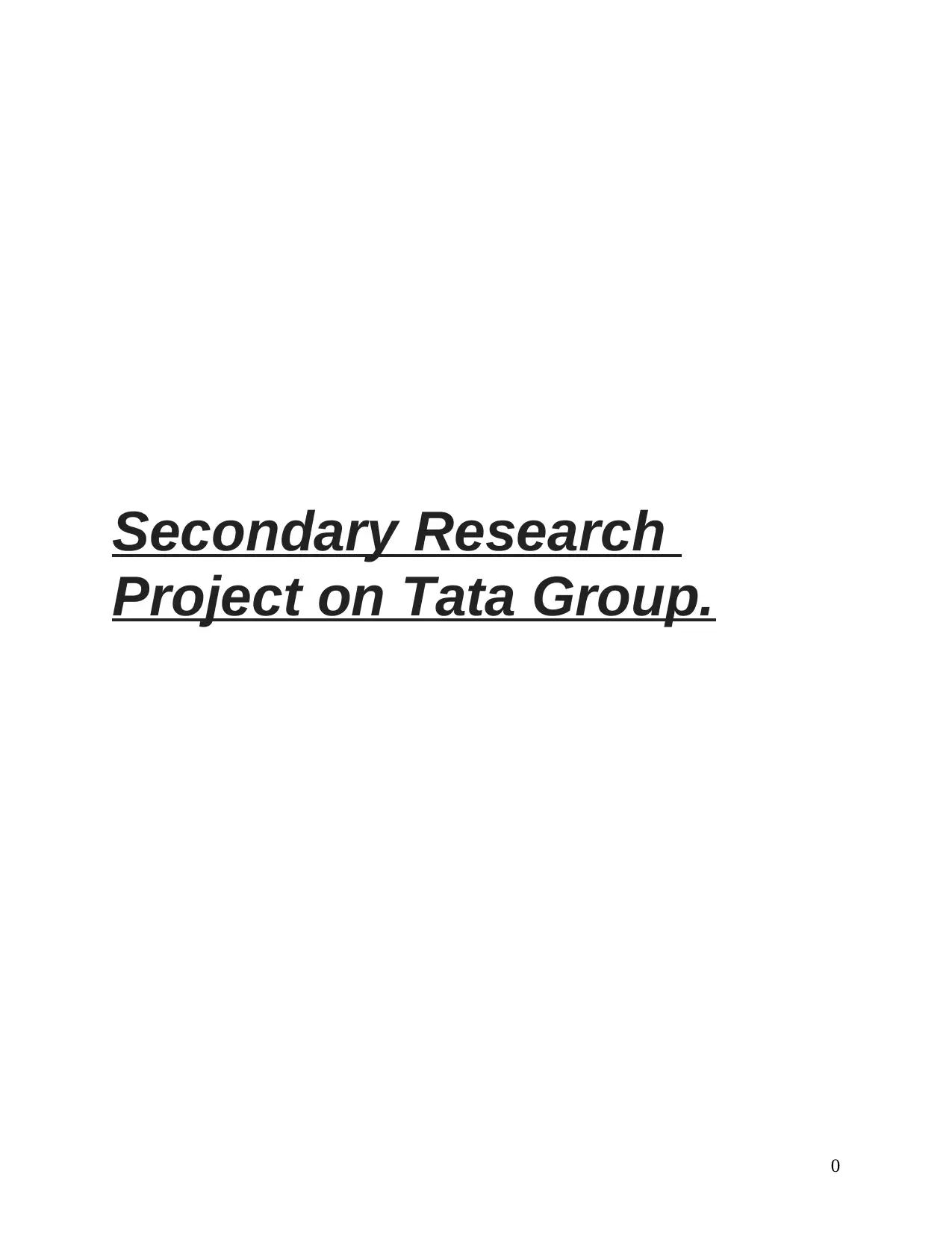
Secondary Research
Project on Tata Group.
0
Project on Tata Group.
0
Paraphrase This Document
Need a fresh take? Get an instant paraphrase of this document with our AI Paraphraser
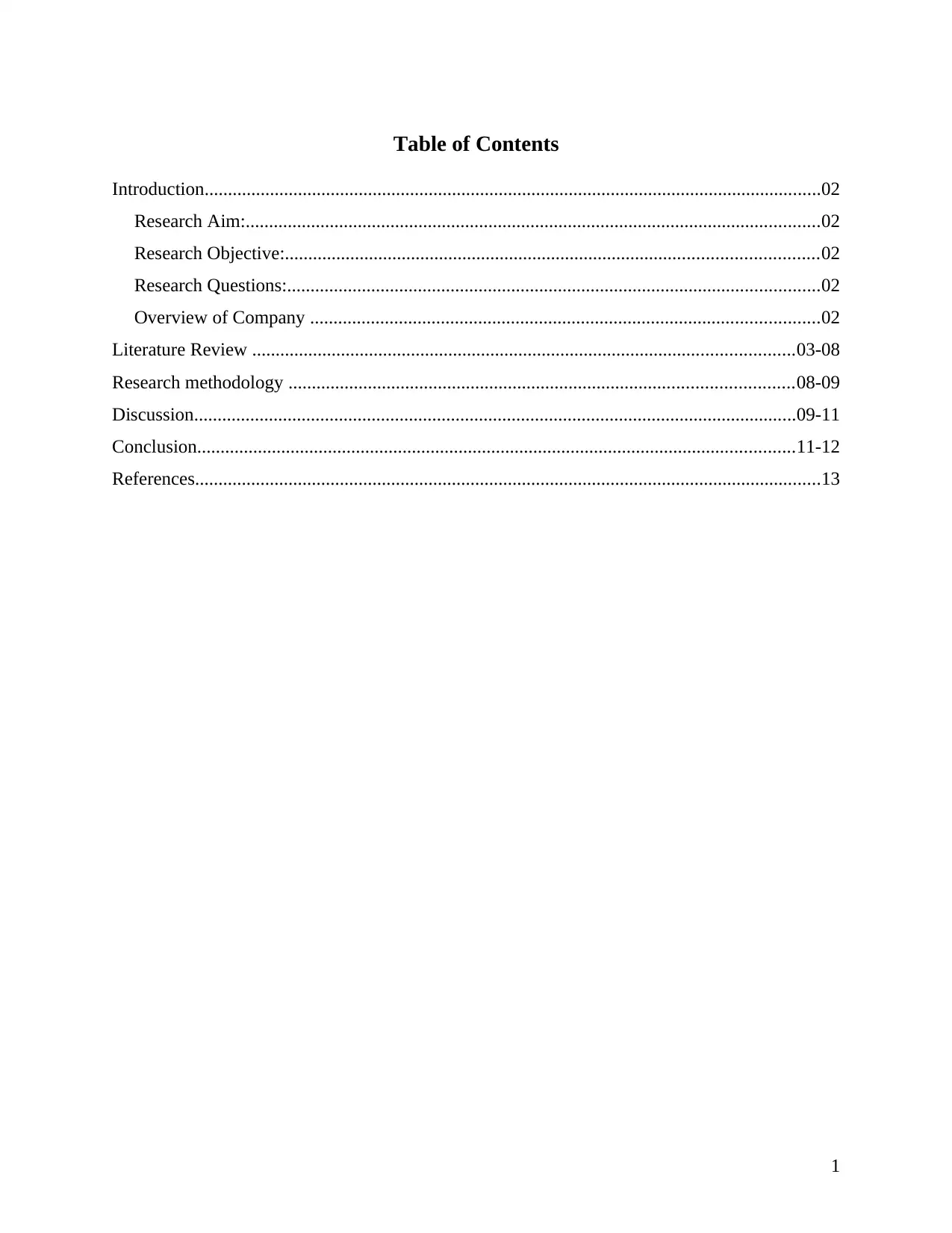
Table of Contents
Introduction....................................................................................................................................02
Research Aim:...........................................................................................................................02
Research Objective:..................................................................................................................02
Research Questions:..................................................................................................................02
Overview of Company .............................................................................................................02
Literature Review ....................................................................................................................03-08
Research methodology ............................................................................................................08-09
Discussion.................................................................................................................................09-11
Conclusion................................................................................................................................11-12
References......................................................................................................................................13
1
Introduction....................................................................................................................................02
Research Aim:...........................................................................................................................02
Research Objective:..................................................................................................................02
Research Questions:..................................................................................................................02
Overview of Company .............................................................................................................02
Literature Review ....................................................................................................................03-08
Research methodology ............................................................................................................08-09
Discussion.................................................................................................................................09-11
Conclusion................................................................................................................................11-12
References......................................................................................................................................13
1
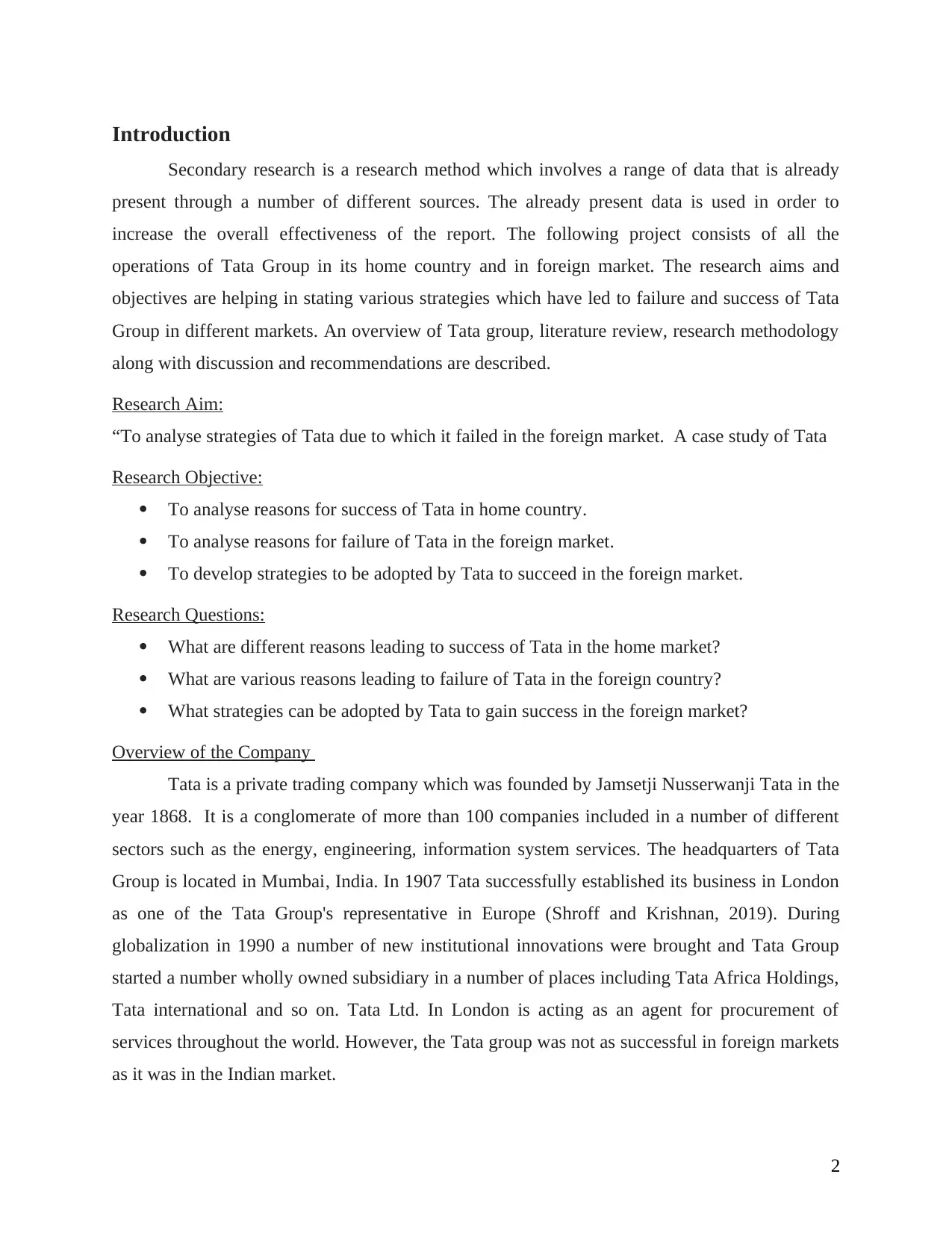
Introduction
Secondary research is a research method which involves a range of data that is already
present through a number of different sources. The already present data is used in order to
increase the overall effectiveness of the report. The following project consists of all the
operations of Tata Group in its home country and in foreign market. The research aims and
objectives are helping in stating various strategies which have led to failure and success of Tata
Group in different markets. An overview of Tata group, literature review, research methodology
along with discussion and recommendations are described.
Research Aim:
“To analyse strategies of Tata due to which it failed in the foreign market. A case study of Tata
Research Objective:
To analyse reasons for success of Tata in home country.
To analyse reasons for failure of Tata in the foreign market.
To develop strategies to be adopted by Tata to succeed in the foreign market.
Research Questions:
What are different reasons leading to success of Tata in the home market?
What are various reasons leading to failure of Tata in the foreign country?
What strategies can be adopted by Tata to gain success in the foreign market?
Overview of the Company
Tata is a private trading company which was founded by Jamsetji Nusserwanji Tata in the
year 1868. It is a conglomerate of more than 100 companies included in a number of different
sectors such as the energy, engineering, information system services. The headquarters of Tata
Group is located in Mumbai, India. In 1907 Tata successfully established its business in London
as one of the Tata Group's representative in Europe (Shroff and Krishnan, 2019). During
globalization in 1990 a number of new institutional innovations were brought and Tata Group
started a number wholly owned subsidiary in a number of places including Tata Africa Holdings,
Tata international and so on. Tata Ltd. In London is acting as an agent for procurement of
services throughout the world. However, the Tata group was not as successful in foreign markets
as it was in the Indian market.
2
Secondary research is a research method which involves a range of data that is already
present through a number of different sources. The already present data is used in order to
increase the overall effectiveness of the report. The following project consists of all the
operations of Tata Group in its home country and in foreign market. The research aims and
objectives are helping in stating various strategies which have led to failure and success of Tata
Group in different markets. An overview of Tata group, literature review, research methodology
along with discussion and recommendations are described.
Research Aim:
“To analyse strategies of Tata due to which it failed in the foreign market. A case study of Tata
Research Objective:
To analyse reasons for success of Tata in home country.
To analyse reasons for failure of Tata in the foreign market.
To develop strategies to be adopted by Tata to succeed in the foreign market.
Research Questions:
What are different reasons leading to success of Tata in the home market?
What are various reasons leading to failure of Tata in the foreign country?
What strategies can be adopted by Tata to gain success in the foreign market?
Overview of the Company
Tata is a private trading company which was founded by Jamsetji Nusserwanji Tata in the
year 1868. It is a conglomerate of more than 100 companies included in a number of different
sectors such as the energy, engineering, information system services. The headquarters of Tata
Group is located in Mumbai, India. In 1907 Tata successfully established its business in London
as one of the Tata Group's representative in Europe (Shroff and Krishnan, 2019). During
globalization in 1990 a number of new institutional innovations were brought and Tata Group
started a number wholly owned subsidiary in a number of places including Tata Africa Holdings,
Tata international and so on. Tata Ltd. In London is acting as an agent for procurement of
services throughout the world. However, the Tata group was not as successful in foreign markets
as it was in the Indian market.
2
⊘ This is a preview!⊘
Do you want full access?
Subscribe today to unlock all pages.

Trusted by 1+ million students worldwide
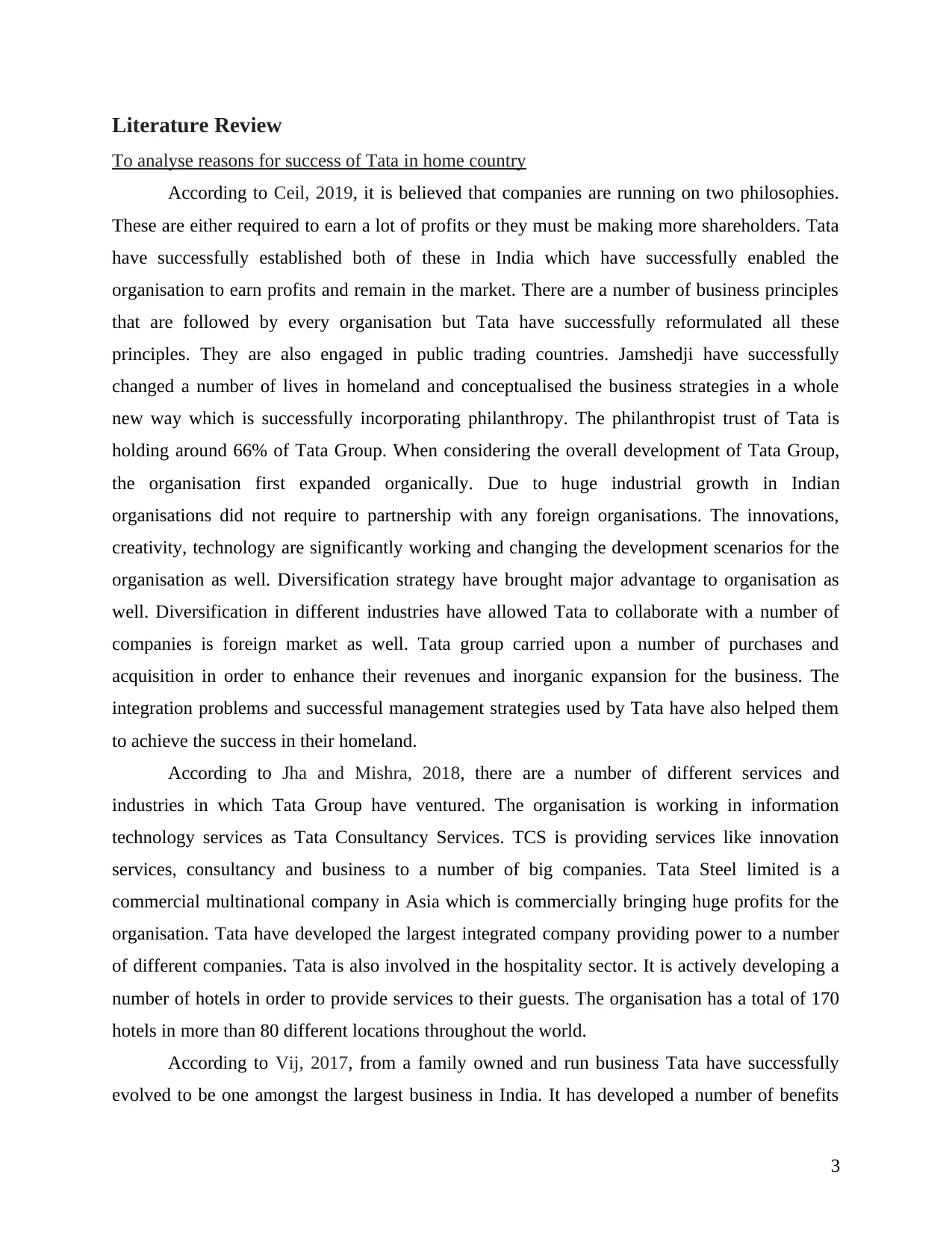
Literature Review
To analyse reasons for success of Tata in home country
According to Ceil, 2019, it is believed that companies are running on two philosophies.
These are either required to earn a lot of profits or they must be making more shareholders. Tata
have successfully established both of these in India which have successfully enabled the
organisation to earn profits and remain in the market. There are a number of business principles
that are followed by every organisation but Tata have successfully reformulated all these
principles. They are also engaged in public trading countries. Jamshedji have successfully
changed a number of lives in homeland and conceptualised the business strategies in a whole
new way which is successfully incorporating philanthropy. The philanthropist trust of Tata is
holding around 66% of Tata Group. When considering the overall development of Tata Group,
the organisation first expanded organically. Due to huge industrial growth in Indian
organisations did not require to partnership with any foreign organisations. The innovations,
creativity, technology are significantly working and changing the development scenarios for the
organisation as well. Diversification strategy have brought major advantage to organisation as
well. Diversification in different industries have allowed Tata to collaborate with a number of
companies is foreign market as well. Tata group carried upon a number of purchases and
acquisition in order to enhance their revenues and inorganic expansion for the business. The
integration problems and successful management strategies used by Tata have also helped them
to achieve the success in their homeland.
According to Jha and Mishra, 2018, there are a number of different services and
industries in which Tata Group have ventured. The organisation is working in information
technology services as Tata Consultancy Services. TCS is providing services like innovation
services, consultancy and business to a number of big companies. Tata Steel limited is a
commercial multinational company in Asia which is commercially bringing huge profits for the
organisation. Tata have developed the largest integrated company providing power to a number
of different companies. Tata is also involved in the hospitality sector. It is actively developing a
number of hotels in order to provide services to their guests. The organisation has a total of 170
hotels in more than 80 different locations throughout the world.
According to Vij, 2017, from a family owned and run business Tata have successfully
evolved to be one amongst the largest business in India. It has developed a number of benefits
3
To analyse reasons for success of Tata in home country
According to Ceil, 2019, it is believed that companies are running on two philosophies.
These are either required to earn a lot of profits or they must be making more shareholders. Tata
have successfully established both of these in India which have successfully enabled the
organisation to earn profits and remain in the market. There are a number of business principles
that are followed by every organisation but Tata have successfully reformulated all these
principles. They are also engaged in public trading countries. Jamshedji have successfully
changed a number of lives in homeland and conceptualised the business strategies in a whole
new way which is successfully incorporating philanthropy. The philanthropist trust of Tata is
holding around 66% of Tata Group. When considering the overall development of Tata Group,
the organisation first expanded organically. Due to huge industrial growth in Indian
organisations did not require to partnership with any foreign organisations. The innovations,
creativity, technology are significantly working and changing the development scenarios for the
organisation as well. Diversification strategy have brought major advantage to organisation as
well. Diversification in different industries have allowed Tata to collaborate with a number of
companies is foreign market as well. Tata group carried upon a number of purchases and
acquisition in order to enhance their revenues and inorganic expansion for the business. The
integration problems and successful management strategies used by Tata have also helped them
to achieve the success in their homeland.
According to Jha and Mishra, 2018, there are a number of different services and
industries in which Tata Group have ventured. The organisation is working in information
technology services as Tata Consultancy Services. TCS is providing services like innovation
services, consultancy and business to a number of big companies. Tata Steel limited is a
commercial multinational company in Asia which is commercially bringing huge profits for the
organisation. Tata have developed the largest integrated company providing power to a number
of different companies. Tata is also involved in the hospitality sector. It is actively developing a
number of hotels in order to provide services to their guests. The organisation has a total of 170
hotels in more than 80 different locations throughout the world.
According to Vij, 2017, from a family owned and run business Tata have successfully
evolved to be one amongst the largest business in India. It has developed a number of benefits
3
Paraphrase This Document
Need a fresh take? Get an instant paraphrase of this document with our AI Paraphraser
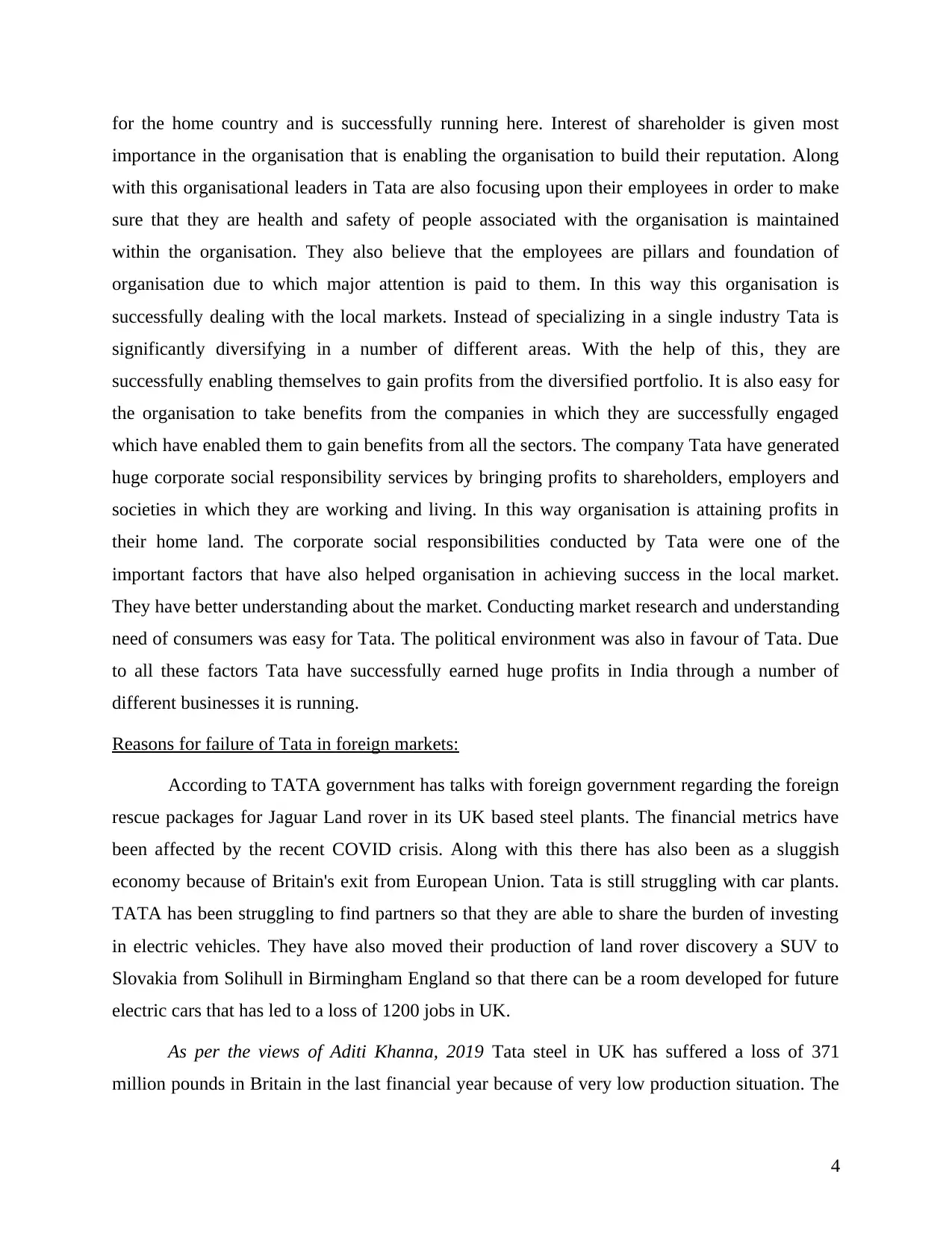
for the home country and is successfully running here. Interest of shareholder is given most
importance in the organisation that is enabling the organisation to build their reputation. Along
with this organisational leaders in Tata are also focusing upon their employees in order to make
sure that they are health and safety of people associated with the organisation is maintained
within the organisation. They also believe that the employees are pillars and foundation of
organisation due to which major attention is paid to them. In this way this organisation is
successfully dealing with the local markets. Instead of specializing in a single industry Tata is
significantly diversifying in a number of different areas. With the help of this, they are
successfully enabling themselves to gain profits from the diversified portfolio. It is also easy for
the organisation to take benefits from the companies in which they are successfully engaged
which have enabled them to gain benefits from all the sectors. The company Tata have generated
huge corporate social responsibility services by bringing profits to shareholders, employers and
societies in which they are working and living. In this way organisation is attaining profits in
their home land. The corporate social responsibilities conducted by Tata were one of the
important factors that have also helped organisation in achieving success in the local market.
They have better understanding about the market. Conducting market research and understanding
need of consumers was easy for Tata. The political environment was also in favour of Tata. Due
to all these factors Tata have successfully earned huge profits in India through a number of
different businesses it is running.
Reasons for failure of Tata in foreign markets:
According to TATA government has talks with foreign government regarding the foreign
rescue packages for Jaguar Land rover in its UK based steel plants. The financial metrics have
been affected by the recent COVID crisis. Along with this there has also been as a sluggish
economy because of Britain's exit from European Union. Tata is still struggling with car plants.
TATA has been struggling to find partners so that they are able to share the burden of investing
in electric vehicles. They have also moved their production of land rover discovery a SUV to
Slovakia from Solihull in Birmingham England so that there can be a room developed for future
electric cars that has led to a loss of 1200 jobs in UK.
As per the views of Aditi Khanna, 2019 Tata steel in UK has suffered a loss of 371
million pounds in Britain in the last financial year because of very low production situation. The
4
importance in the organisation that is enabling the organisation to build their reputation. Along
with this organisational leaders in Tata are also focusing upon their employees in order to make
sure that they are health and safety of people associated with the organisation is maintained
within the organisation. They also believe that the employees are pillars and foundation of
organisation due to which major attention is paid to them. In this way this organisation is
successfully dealing with the local markets. Instead of specializing in a single industry Tata is
significantly diversifying in a number of different areas. With the help of this, they are
successfully enabling themselves to gain profits from the diversified portfolio. It is also easy for
the organisation to take benefits from the companies in which they are successfully engaged
which have enabled them to gain benefits from all the sectors. The company Tata have generated
huge corporate social responsibility services by bringing profits to shareholders, employers and
societies in which they are working and living. In this way organisation is attaining profits in
their home land. The corporate social responsibilities conducted by Tata were one of the
important factors that have also helped organisation in achieving success in the local market.
They have better understanding about the market. Conducting market research and understanding
need of consumers was easy for Tata. The political environment was also in favour of Tata. Due
to all these factors Tata have successfully earned huge profits in India through a number of
different businesses it is running.
Reasons for failure of Tata in foreign markets:
According to TATA government has talks with foreign government regarding the foreign
rescue packages for Jaguar Land rover in its UK based steel plants. The financial metrics have
been affected by the recent COVID crisis. Along with this there has also been as a sluggish
economy because of Britain's exit from European Union. Tata is still struggling with car plants.
TATA has been struggling to find partners so that they are able to share the burden of investing
in electric vehicles. They have also moved their production of land rover discovery a SUV to
Slovakia from Solihull in Birmingham England so that there can be a room developed for future
electric cars that has led to a loss of 1200 jobs in UK.
As per the views of Aditi Khanna, 2019 Tata steel in UK has suffered a loss of 371
million pounds in Britain in the last financial year because of very low production situation. The
4
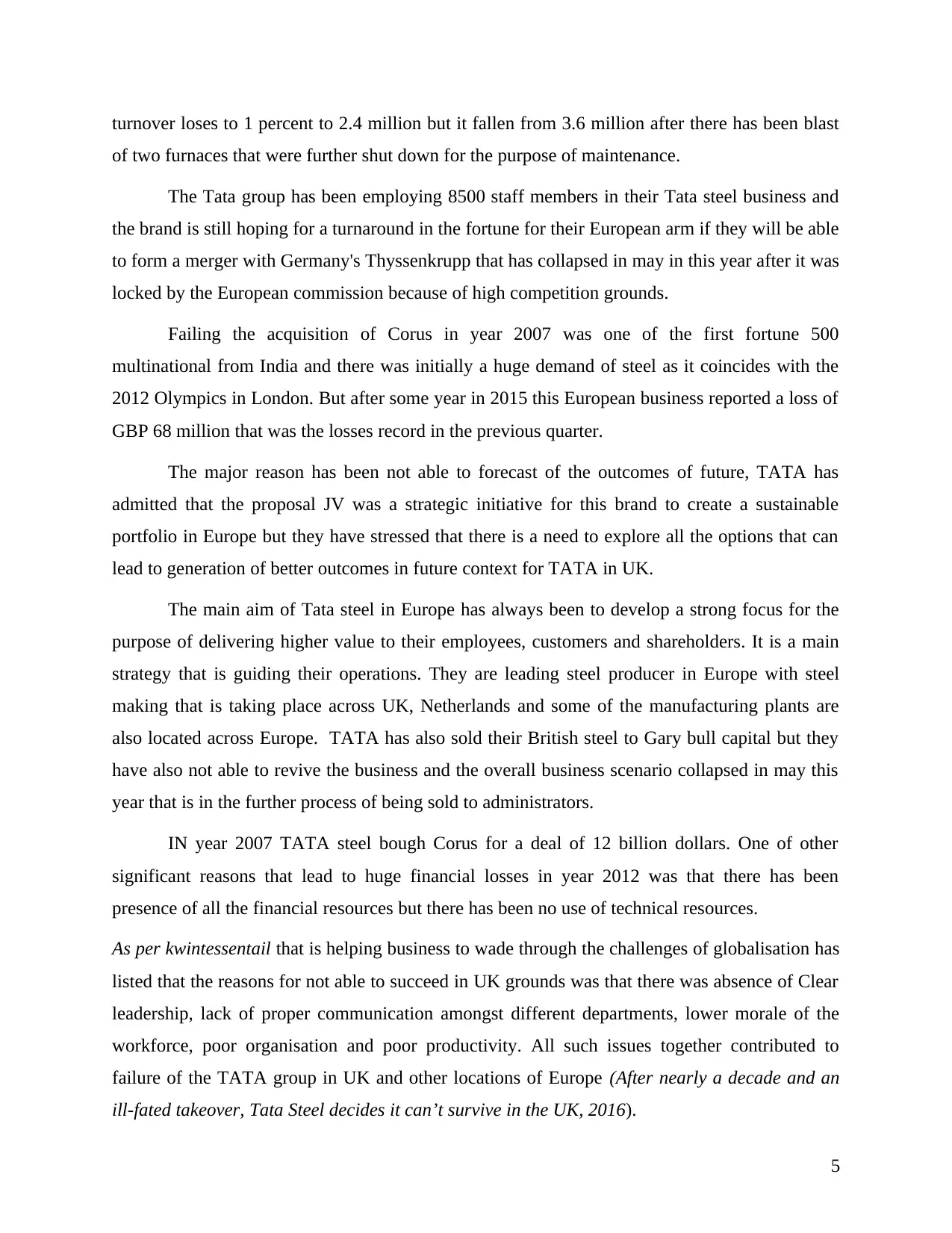
turnover loses to 1 percent to 2.4 million but it fallen from 3.6 million after there has been blast
of two furnaces that were further shut down for the purpose of maintenance.
The Tata group has been employing 8500 staff members in their Tata steel business and
the brand is still hoping for a turnaround in the fortune for their European arm if they will be able
to form a merger with Germany's Thyssenkrupp that has collapsed in may in this year after it was
locked by the European commission because of high competition grounds.
Failing the acquisition of Corus in year 2007 was one of the first fortune 500
multinational from India and there was initially a huge demand of steel as it coincides with the
2012 Olympics in London. But after some year in 2015 this European business reported a loss of
GBP 68 million that was the losses record in the previous quarter.
The major reason has been not able to forecast of the outcomes of future, TATA has
admitted that the proposal JV was a strategic initiative for this brand to create a sustainable
portfolio in Europe but they have stressed that there is a need to explore all the options that can
lead to generation of better outcomes in future context for TATA in UK.
The main aim of Tata steel in Europe has always been to develop a strong focus for the
purpose of delivering higher value to their employees, customers and shareholders. It is a main
strategy that is guiding their operations. They are leading steel producer in Europe with steel
making that is taking place across UK, Netherlands and some of the manufacturing plants are
also located across Europe. TATA has also sold their British steel to Gary bull capital but they
have also not able to revive the business and the overall business scenario collapsed in may this
year that is in the further process of being sold to administrators.
IN year 2007 TATA steel bough Corus for a deal of 12 billion dollars. One of other
significant reasons that lead to huge financial losses in year 2012 was that there has been
presence of all the financial resources but there has been no use of technical resources.
As per kwintessentail that is helping business to wade through the challenges of globalisation has
listed that the reasons for not able to succeed in UK grounds was that there was absence of Clear
leadership, lack of proper communication amongst different departments, lower morale of the
workforce, poor organisation and poor productivity. All such issues together contributed to
failure of the TATA group in UK and other locations of Europe (After nearly a decade and an
ill-fated takeover, Tata Steel decides it can’t survive in the UK, 2016).
5
of two furnaces that were further shut down for the purpose of maintenance.
The Tata group has been employing 8500 staff members in their Tata steel business and
the brand is still hoping for a turnaround in the fortune for their European arm if they will be able
to form a merger with Germany's Thyssenkrupp that has collapsed in may in this year after it was
locked by the European commission because of high competition grounds.
Failing the acquisition of Corus in year 2007 was one of the first fortune 500
multinational from India and there was initially a huge demand of steel as it coincides with the
2012 Olympics in London. But after some year in 2015 this European business reported a loss of
GBP 68 million that was the losses record in the previous quarter.
The major reason has been not able to forecast of the outcomes of future, TATA has
admitted that the proposal JV was a strategic initiative for this brand to create a sustainable
portfolio in Europe but they have stressed that there is a need to explore all the options that can
lead to generation of better outcomes in future context for TATA in UK.
The main aim of Tata steel in Europe has always been to develop a strong focus for the
purpose of delivering higher value to their employees, customers and shareholders. It is a main
strategy that is guiding their operations. They are leading steel producer in Europe with steel
making that is taking place across UK, Netherlands and some of the manufacturing plants are
also located across Europe. TATA has also sold their British steel to Gary bull capital but they
have also not able to revive the business and the overall business scenario collapsed in may this
year that is in the further process of being sold to administrators.
IN year 2007 TATA steel bough Corus for a deal of 12 billion dollars. One of other
significant reasons that lead to huge financial losses in year 2012 was that there has been
presence of all the financial resources but there has been no use of technical resources.
As per kwintessentail that is helping business to wade through the challenges of globalisation has
listed that the reasons for not able to succeed in UK grounds was that there was absence of Clear
leadership, lack of proper communication amongst different departments, lower morale of the
workforce, poor organisation and poor productivity. All such issues together contributed to
failure of the TATA group in UK and other locations of Europe (After nearly a decade and an
ill-fated takeover, Tata Steel decides it can’t survive in the UK, 2016).
5
⊘ This is a preview!⊘
Do you want full access?
Subscribe today to unlock all pages.

Trusted by 1+ million students worldwide
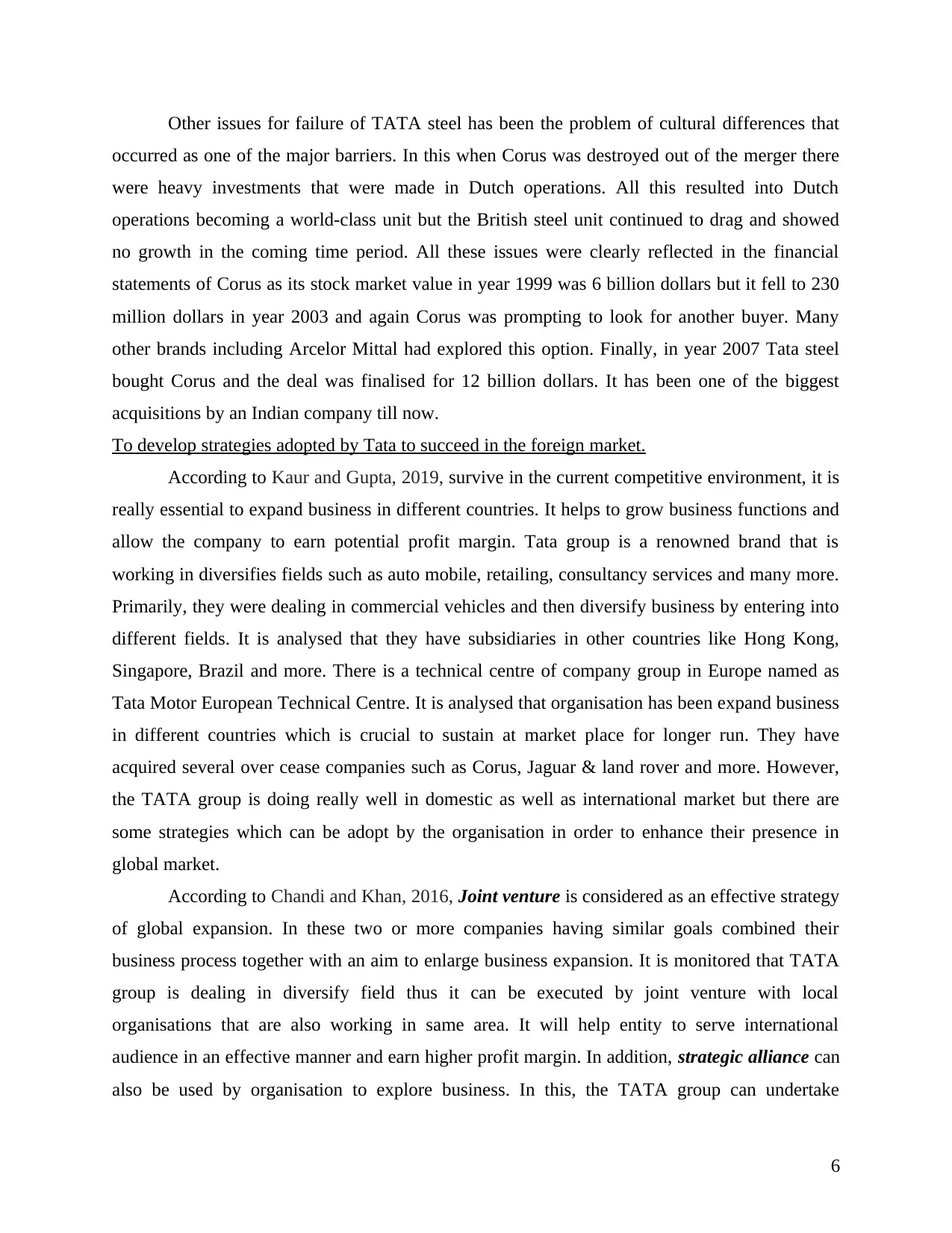
Other issues for failure of TATA steel has been the problem of cultural differences that
occurred as one of the major barriers. In this when Corus was destroyed out of the merger there
were heavy investments that were made in Dutch operations. All this resulted into Dutch
operations becoming a world-class unit but the British steel unit continued to drag and showed
no growth in the coming time period. All these issues were clearly reflected in the financial
statements of Corus as its stock market value in year 1999 was 6 billion dollars but it fell to 230
million dollars in year 2003 and again Corus was prompting to look for another buyer. Many
other brands including Arcelor Mittal had explored this option. Finally, in year 2007 Tata steel
bought Corus and the deal was finalised for 12 billion dollars. It has been one of the biggest
acquisitions by an Indian company till now.
To develop strategies adopted by Tata to succeed in the foreign market.
According to Kaur and Gupta, 2019, survive in the current competitive environment, it is
really essential to expand business in different countries. It helps to grow business functions and
allow the company to earn potential profit margin. Tata group is a renowned brand that is
working in diversifies fields such as auto mobile, retailing, consultancy services and many more.
Primarily, they were dealing in commercial vehicles and then diversify business by entering into
different fields. It is analysed that they have subsidiaries in other countries like Hong Kong,
Singapore, Brazil and more. There is a technical centre of company group in Europe named as
Tata Motor European Technical Centre. It is analysed that organisation has been expand business
in different countries which is crucial to sustain at market place for longer run. They have
acquired several over cease companies such as Corus, Jaguar & land rover and more. However,
the TATA group is doing really well in domestic as well as international market but there are
some strategies which can be adopt by the organisation in order to enhance their presence in
global market.
According to Chandi and Khan, 2016, Joint venture is considered as an effective strategy
of global expansion. In these two or more companies having similar goals combined their
business process together with an aim to enlarge business expansion. It is monitored that TATA
group is dealing in diversify field thus it can be executed by joint venture with local
organisations that are also working in same area. It will help entity to serve international
audience in an effective manner and earn higher profit margin. In addition, strategic alliance can
also be used by organisation to explore business. In this, the TATA group can undertake
6
occurred as one of the major barriers. In this when Corus was destroyed out of the merger there
were heavy investments that were made in Dutch operations. All this resulted into Dutch
operations becoming a world-class unit but the British steel unit continued to drag and showed
no growth in the coming time period. All these issues were clearly reflected in the financial
statements of Corus as its stock market value in year 1999 was 6 billion dollars but it fell to 230
million dollars in year 2003 and again Corus was prompting to look for another buyer. Many
other brands including Arcelor Mittal had explored this option. Finally, in year 2007 Tata steel
bought Corus and the deal was finalised for 12 billion dollars. It has been one of the biggest
acquisitions by an Indian company till now.
To develop strategies adopted by Tata to succeed in the foreign market.
According to Kaur and Gupta, 2019, survive in the current competitive environment, it is
really essential to expand business in different countries. It helps to grow business functions and
allow the company to earn potential profit margin. Tata group is a renowned brand that is
working in diversifies fields such as auto mobile, retailing, consultancy services and many more.
Primarily, they were dealing in commercial vehicles and then diversify business by entering into
different fields. It is analysed that they have subsidiaries in other countries like Hong Kong,
Singapore, Brazil and more. There is a technical centre of company group in Europe named as
Tata Motor European Technical Centre. It is analysed that organisation has been expand business
in different countries which is crucial to sustain at market place for longer run. They have
acquired several over cease companies such as Corus, Jaguar & land rover and more. However,
the TATA group is doing really well in domestic as well as international market but there are
some strategies which can be adopt by the organisation in order to enhance their presence in
global market.
According to Chandi and Khan, 2016, Joint venture is considered as an effective strategy
of global expansion. In these two or more companies having similar goals combined their
business process together with an aim to enlarge business expansion. It is monitored that TATA
group is dealing in diversify field thus it can be executed by joint venture with local
organisations that are also working in same area. It will help entity to serve international
audience in an effective manner and earn higher profit margin. In addition, strategic alliance can
also be used by organisation to explore business. In this, the TATA group can undertake
6
Paraphrase This Document
Need a fresh take? Get an instant paraphrase of this document with our AI Paraphraser
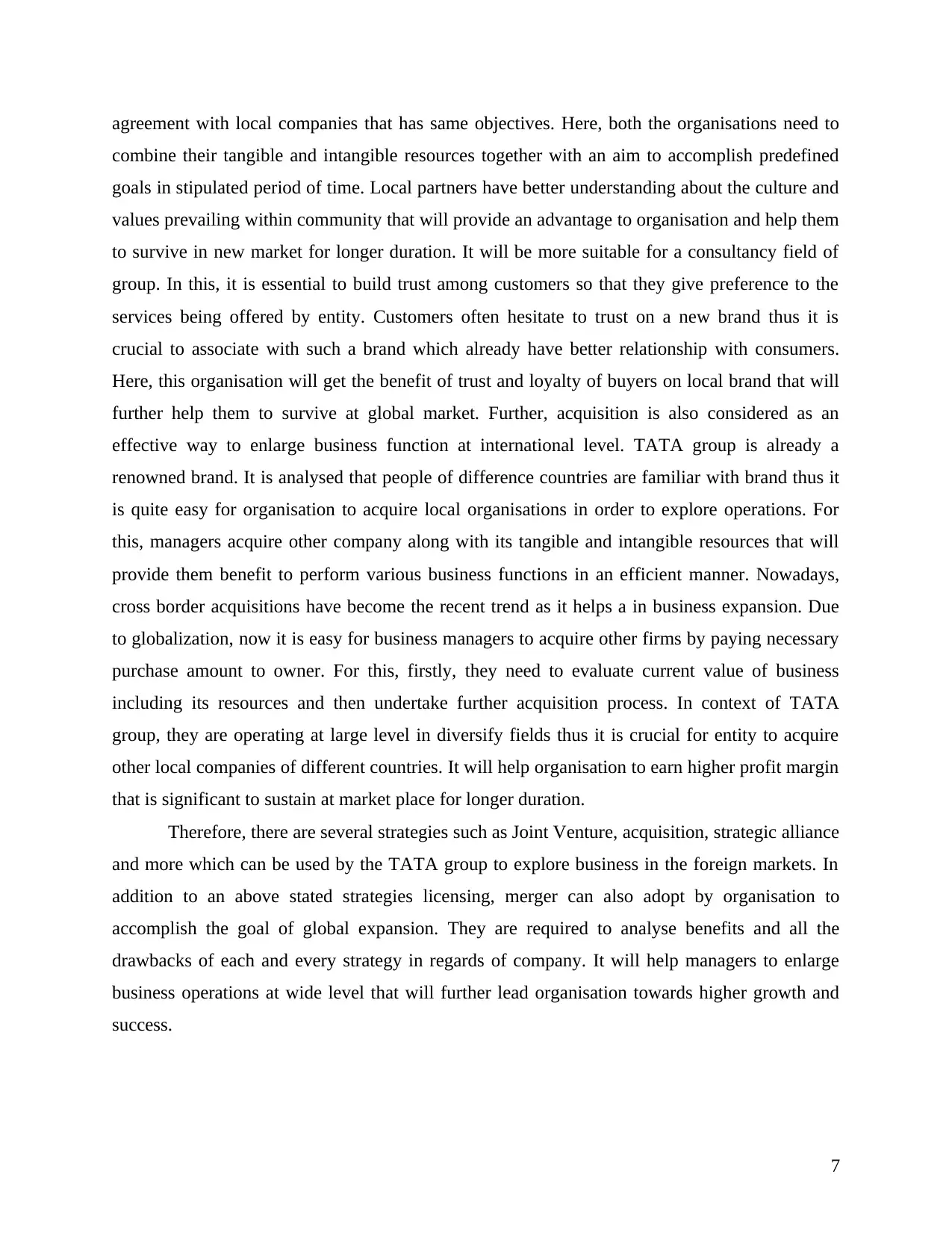
agreement with local companies that has same objectives. Here, both the organisations need to
combine their tangible and intangible resources together with an aim to accomplish predefined
goals in stipulated period of time. Local partners have better understanding about the culture and
values prevailing within community that will provide an advantage to organisation and help them
to survive in new market for longer duration. It will be more suitable for a consultancy field of
group. In this, it is essential to build trust among customers so that they give preference to the
services being offered by entity. Customers often hesitate to trust on a new brand thus it is
crucial to associate with such a brand which already have better relationship with consumers.
Here, this organisation will get the benefit of trust and loyalty of buyers on local brand that will
further help them to survive at global market. Further, acquisition is also considered as an
effective way to enlarge business function at international level. TATA group is already a
renowned brand. It is analysed that people of difference countries are familiar with brand thus it
is quite easy for organisation to acquire local organisations in order to explore operations. For
this, managers acquire other company along with its tangible and intangible resources that will
provide them benefit to perform various business functions in an efficient manner. Nowadays,
cross border acquisitions have become the recent trend as it helps a in business expansion. Due
to globalization, now it is easy for business managers to acquire other firms by paying necessary
purchase amount to owner. For this, firstly, they need to evaluate current value of business
including its resources and then undertake further acquisition process. In context of TATA
group, they are operating at large level in diversify fields thus it is crucial for entity to acquire
other local companies of different countries. It will help organisation to earn higher profit margin
that is significant to sustain at market place for longer duration.
Therefore, there are several strategies such as Joint Venture, acquisition, strategic alliance
and more which can be used by the TATA group to explore business in the foreign markets. In
addition to an above stated strategies licensing, merger can also adopt by organisation to
accomplish the goal of global expansion. They are required to analyse benefits and all the
drawbacks of each and every strategy in regards of company. It will help managers to enlarge
business operations at wide level that will further lead organisation towards higher growth and
success.
7
combine their tangible and intangible resources together with an aim to accomplish predefined
goals in stipulated period of time. Local partners have better understanding about the culture and
values prevailing within community that will provide an advantage to organisation and help them
to survive in new market for longer duration. It will be more suitable for a consultancy field of
group. In this, it is essential to build trust among customers so that they give preference to the
services being offered by entity. Customers often hesitate to trust on a new brand thus it is
crucial to associate with such a brand which already have better relationship with consumers.
Here, this organisation will get the benefit of trust and loyalty of buyers on local brand that will
further help them to survive at global market. Further, acquisition is also considered as an
effective way to enlarge business function at international level. TATA group is already a
renowned brand. It is analysed that people of difference countries are familiar with brand thus it
is quite easy for organisation to acquire local organisations in order to explore operations. For
this, managers acquire other company along with its tangible and intangible resources that will
provide them benefit to perform various business functions in an efficient manner. Nowadays,
cross border acquisitions have become the recent trend as it helps a in business expansion. Due
to globalization, now it is easy for business managers to acquire other firms by paying necessary
purchase amount to owner. For this, firstly, they need to evaluate current value of business
including its resources and then undertake further acquisition process. In context of TATA
group, they are operating at large level in diversify fields thus it is crucial for entity to acquire
other local companies of different countries. It will help organisation to earn higher profit margin
that is significant to sustain at market place for longer duration.
Therefore, there are several strategies such as Joint Venture, acquisition, strategic alliance
and more which can be used by the TATA group to explore business in the foreign markets. In
addition to an above stated strategies licensing, merger can also adopt by organisation to
accomplish the goal of global expansion. They are required to analyse benefits and all the
drawbacks of each and every strategy in regards of company. It will help managers to enlarge
business operations at wide level that will further lead organisation towards higher growth and
success.
7
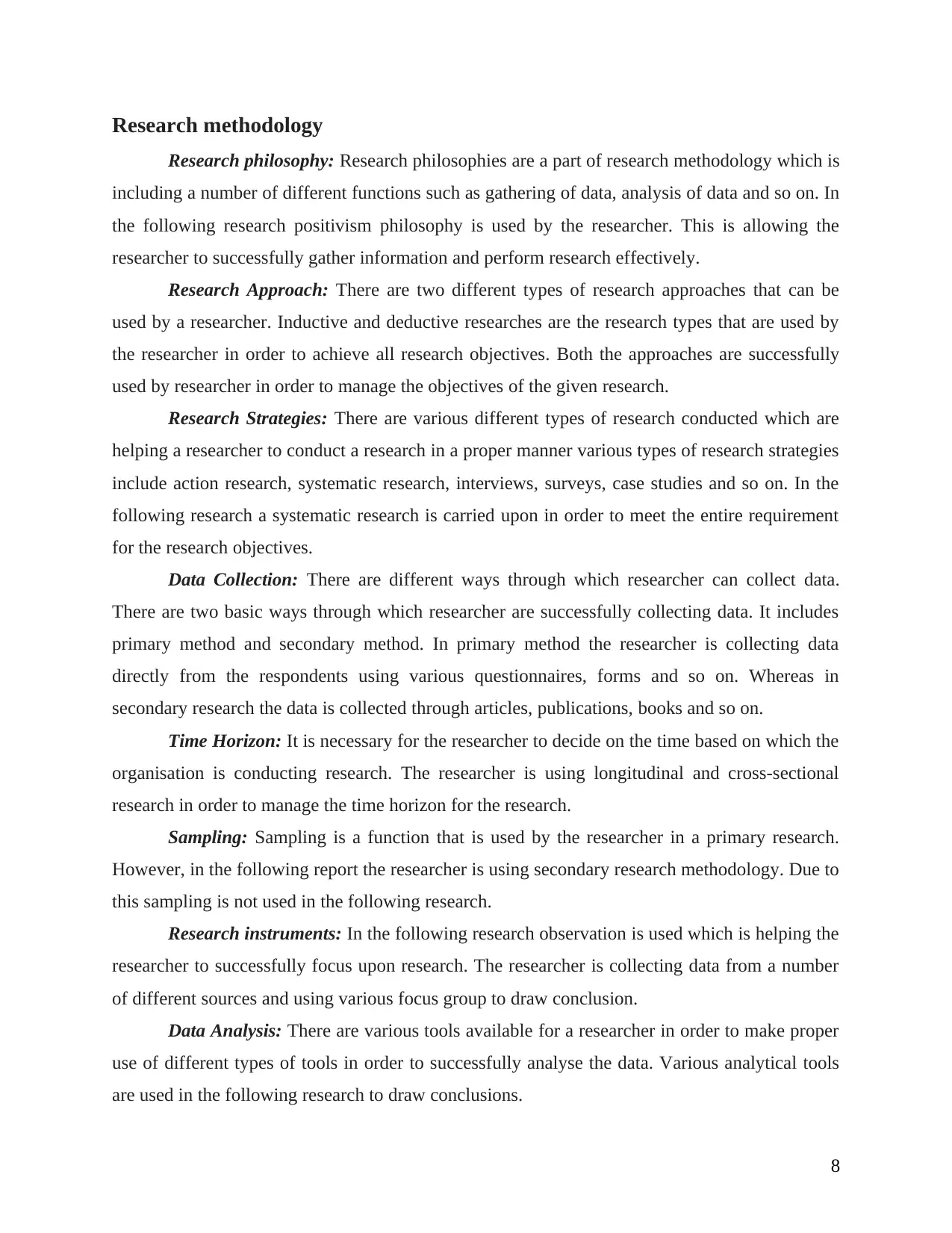
Research methodology
Research philosophy: Research philosophies are a part of research methodology which is
including a number of different functions such as gathering of data, analysis of data and so on. In
the following research positivism philosophy is used by the researcher. This is allowing the
researcher to successfully gather information and perform research effectively.
Research Approach: There are two different types of research approaches that can be
used by a researcher. Inductive and deductive researches are the research types that are used by
the researcher in order to achieve all research objectives. Both the approaches are successfully
used by researcher in order to manage the objectives of the given research.
Research Strategies: There are various different types of research conducted which are
helping a researcher to conduct a research in a proper manner various types of research strategies
include action research, systematic research, interviews, surveys, case studies and so on. In the
following research a systematic research is carried upon in order to meet the entire requirement
for the research objectives.
Data Collection: There are different ways through which researcher can collect data.
There are two basic ways through which researcher are successfully collecting data. It includes
primary method and secondary method. In primary method the researcher is collecting data
directly from the respondents using various questionnaires, forms and so on. Whereas in
secondary research the data is collected through articles, publications, books and so on.
Time Horizon: It is necessary for the researcher to decide on the time based on which the
organisation is conducting research. The researcher is using longitudinal and cross-sectional
research in order to manage the time horizon for the research.
Sampling: Sampling is a function that is used by the researcher in a primary research.
However, in the following report the researcher is using secondary research methodology. Due to
this sampling is not used in the following research.
Research instruments: In the following research observation is used which is helping the
researcher to successfully focus upon research. The researcher is collecting data from a number
of different sources and using various focus group to draw conclusion.
Data Analysis: There are various tools available for a researcher in order to make proper
use of different types of tools in order to successfully analyse the data. Various analytical tools
are used in the following research to draw conclusions.
8
Research philosophy: Research philosophies are a part of research methodology which is
including a number of different functions such as gathering of data, analysis of data and so on. In
the following research positivism philosophy is used by the researcher. This is allowing the
researcher to successfully gather information and perform research effectively.
Research Approach: There are two different types of research approaches that can be
used by a researcher. Inductive and deductive researches are the research types that are used by
the researcher in order to achieve all research objectives. Both the approaches are successfully
used by researcher in order to manage the objectives of the given research.
Research Strategies: There are various different types of research conducted which are
helping a researcher to conduct a research in a proper manner various types of research strategies
include action research, systematic research, interviews, surveys, case studies and so on. In the
following research a systematic research is carried upon in order to meet the entire requirement
for the research objectives.
Data Collection: There are different ways through which researcher can collect data.
There are two basic ways through which researcher are successfully collecting data. It includes
primary method and secondary method. In primary method the researcher is collecting data
directly from the respondents using various questionnaires, forms and so on. Whereas in
secondary research the data is collected through articles, publications, books and so on.
Time Horizon: It is necessary for the researcher to decide on the time based on which the
organisation is conducting research. The researcher is using longitudinal and cross-sectional
research in order to manage the time horizon for the research.
Sampling: Sampling is a function that is used by the researcher in a primary research.
However, in the following report the researcher is using secondary research methodology. Due to
this sampling is not used in the following research.
Research instruments: In the following research observation is used which is helping the
researcher to successfully focus upon research. The researcher is collecting data from a number
of different sources and using various focus group to draw conclusion.
Data Analysis: There are various tools available for a researcher in order to make proper
use of different types of tools in order to successfully analyse the data. Various analytical tools
are used in the following research to draw conclusions.
8
⊘ This is a preview!⊘
Do you want full access?
Subscribe today to unlock all pages.

Trusted by 1+ million students worldwide
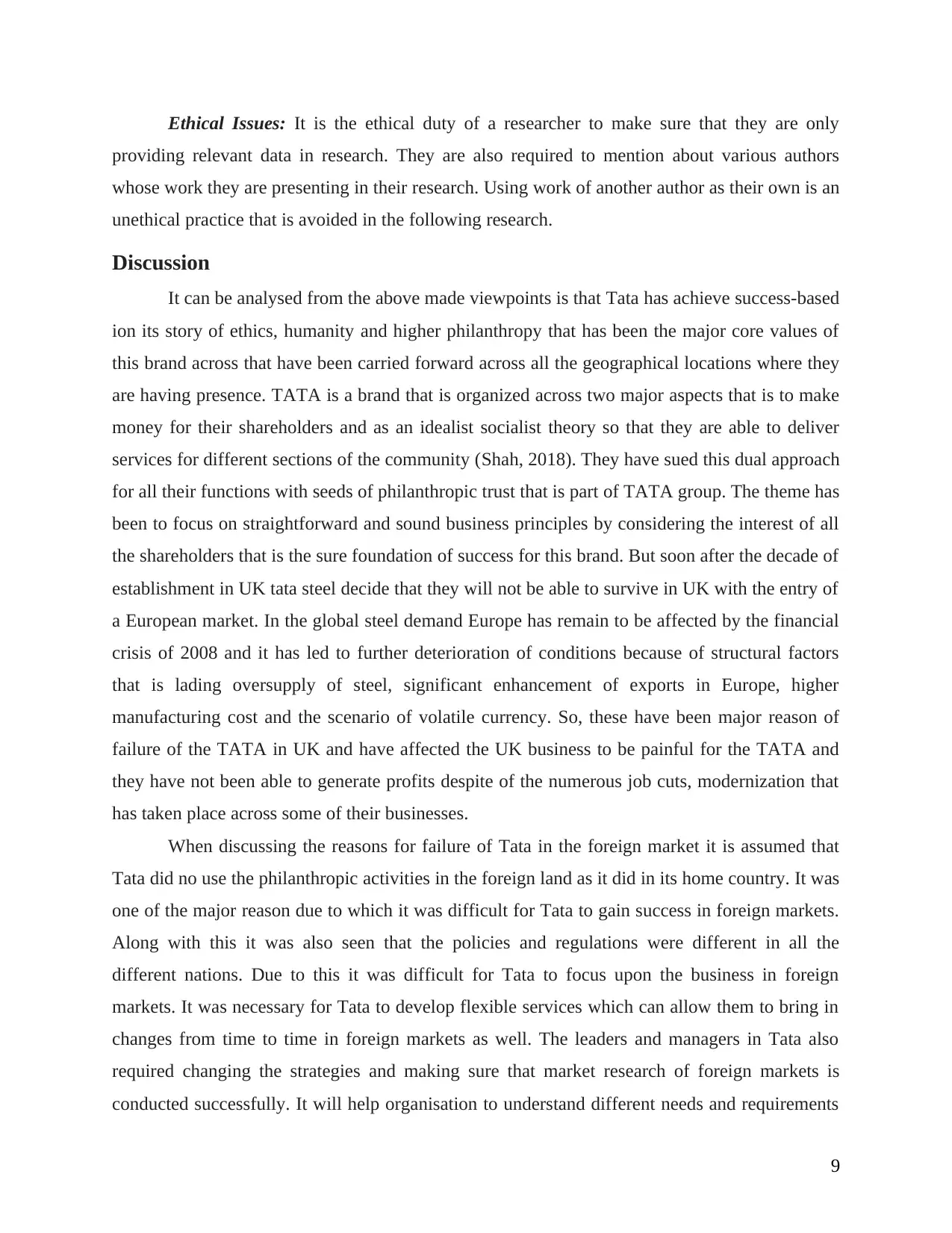
Ethical Issues: It is the ethical duty of a researcher to make sure that they are only
providing relevant data in research. They are also required to mention about various authors
whose work they are presenting in their research. Using work of another author as their own is an
unethical practice that is avoided in the following research.
Discussion
It can be analysed from the above made viewpoints is that Tata has achieve success-based
ion its story of ethics, humanity and higher philanthropy that has been the major core values of
this brand across that have been carried forward across all the geographical locations where they
are having presence. TATA is a brand that is organized across two major aspects that is to make
money for their shareholders and as an idealist socialist theory so that they are able to deliver
services for different sections of the community (Shah, 2018). They have sued this dual approach
for all their functions with seeds of philanthropic trust that is part of TATA group. The theme has
been to focus on straightforward and sound business principles by considering the interest of all
the shareholders that is the sure foundation of success for this brand. But soon after the decade of
establishment in UK tata steel decide that they will not be able to survive in UK with the entry of
a European market. In the global steel demand Europe has remain to be affected by the financial
crisis of 2008 and it has led to further deterioration of conditions because of structural factors
that is lading oversupply of steel, significant enhancement of exports in Europe, higher
manufacturing cost and the scenario of volatile currency. So, these have been major reason of
failure of the TATA in UK and have affected the UK business to be painful for the TATA and
they have not been able to generate profits despite of the numerous job cuts, modernization that
has taken place across some of their businesses.
When discussing the reasons for failure of Tata in the foreign market it is assumed that
Tata did no use the philanthropic activities in the foreign land as it did in its home country. It was
one of the major reason due to which it was difficult for Tata to gain success in foreign markets.
Along with this it was also seen that the policies and regulations were different in all the
different nations. Due to this it was difficult for Tata to focus upon the business in foreign
markets. It was necessary for Tata to develop flexible services which can allow them to bring in
changes from time to time in foreign markets as well. The leaders and managers in Tata also
required changing the strategies and making sure that market research of foreign markets is
conducted successfully. It will help organisation to understand different needs and requirements
9
providing relevant data in research. They are also required to mention about various authors
whose work they are presenting in their research. Using work of another author as their own is an
unethical practice that is avoided in the following research.
Discussion
It can be analysed from the above made viewpoints is that Tata has achieve success-based
ion its story of ethics, humanity and higher philanthropy that has been the major core values of
this brand across that have been carried forward across all the geographical locations where they
are having presence. TATA is a brand that is organized across two major aspects that is to make
money for their shareholders and as an idealist socialist theory so that they are able to deliver
services for different sections of the community (Shah, 2018). They have sued this dual approach
for all their functions with seeds of philanthropic trust that is part of TATA group. The theme has
been to focus on straightforward and sound business principles by considering the interest of all
the shareholders that is the sure foundation of success for this brand. But soon after the decade of
establishment in UK tata steel decide that they will not be able to survive in UK with the entry of
a European market. In the global steel demand Europe has remain to be affected by the financial
crisis of 2008 and it has led to further deterioration of conditions because of structural factors
that is lading oversupply of steel, significant enhancement of exports in Europe, higher
manufacturing cost and the scenario of volatile currency. So, these have been major reason of
failure of the TATA in UK and have affected the UK business to be painful for the TATA and
they have not been able to generate profits despite of the numerous job cuts, modernization that
has taken place across some of their businesses.
When discussing the reasons for failure of Tata in the foreign market it is assumed that
Tata did no use the philanthropic activities in the foreign land as it did in its home country. It was
one of the major reason due to which it was difficult for Tata to gain success in foreign markets.
Along with this it was also seen that the policies and regulations were different in all the
different nations. Due to this it was difficult for Tata to focus upon the business in foreign
markets. It was necessary for Tata to develop flexible services which can allow them to bring in
changes from time to time in foreign markets as well. The leaders and managers in Tata also
required changing the strategies and making sure that market research of foreign markets is
conducted successfully. It will help organisation to understand different needs and requirements
9
Paraphrase This Document
Need a fresh take? Get an instant paraphrase of this document with our AI Paraphraser
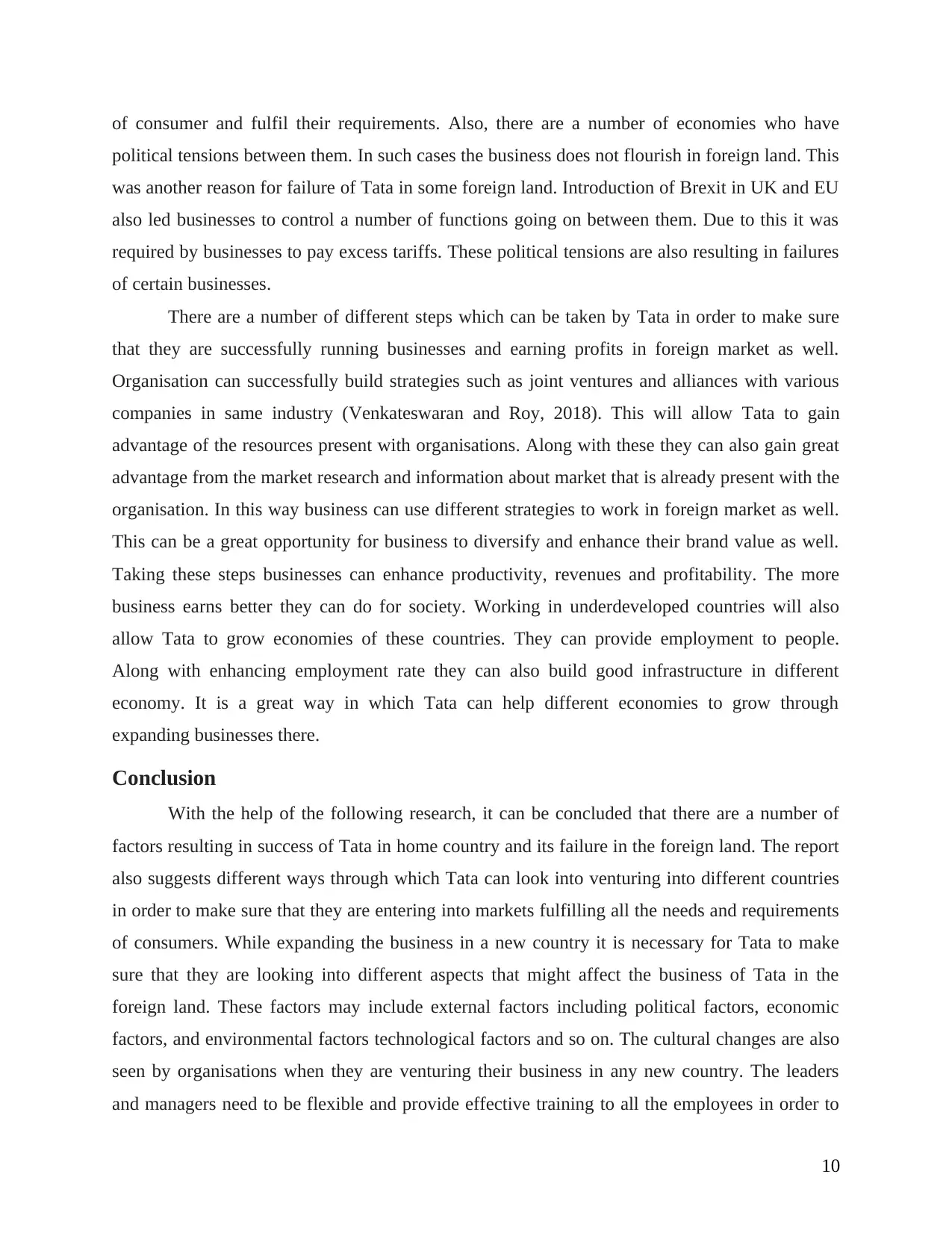
of consumer and fulfil their requirements. Also, there are a number of economies who have
political tensions between them. In such cases the business does not flourish in foreign land. This
was another reason for failure of Tata in some foreign land. Introduction of Brexit in UK and EU
also led businesses to control a number of functions going on between them. Due to this it was
required by businesses to pay excess tariffs. These political tensions are also resulting in failures
of certain businesses.
There are a number of different steps which can be taken by Tata in order to make sure
that they are successfully running businesses and earning profits in foreign market as well.
Organisation can successfully build strategies such as joint ventures and alliances with various
companies in same industry (Venkateswaran and Roy, 2018). This will allow Tata to gain
advantage of the resources present with organisations. Along with these they can also gain great
advantage from the market research and information about market that is already present with the
organisation. In this way business can use different strategies to work in foreign market as well.
This can be a great opportunity for business to diversify and enhance their brand value as well.
Taking these steps businesses can enhance productivity, revenues and profitability. The more
business earns better they can do for society. Working in underdeveloped countries will also
allow Tata to grow economies of these countries. They can provide employment to people.
Along with enhancing employment rate they can also build good infrastructure in different
economy. It is a great way in which Tata can help different economies to grow through
expanding businesses there.
Conclusion
With the help of the following research, it can be concluded that there are a number of
factors resulting in success of Tata in home country and its failure in the foreign land. The report
also suggests different ways through which Tata can look into venturing into different countries
in order to make sure that they are entering into markets fulfilling all the needs and requirements
of consumers. While expanding the business in a new country it is necessary for Tata to make
sure that they are looking into different aspects that might affect the business of Tata in the
foreign land. These factors may include external factors including political factors, economic
factors, and environmental factors technological factors and so on. The cultural changes are also
seen by organisations when they are venturing their business in any new country. The leaders
and managers need to be flexible and provide effective training to all the employees in order to
10
political tensions between them. In such cases the business does not flourish in foreign land. This
was another reason for failure of Tata in some foreign land. Introduction of Brexit in UK and EU
also led businesses to control a number of functions going on between them. Due to this it was
required by businesses to pay excess tariffs. These political tensions are also resulting in failures
of certain businesses.
There are a number of different steps which can be taken by Tata in order to make sure
that they are successfully running businesses and earning profits in foreign market as well.
Organisation can successfully build strategies such as joint ventures and alliances with various
companies in same industry (Venkateswaran and Roy, 2018). This will allow Tata to gain
advantage of the resources present with organisations. Along with these they can also gain great
advantage from the market research and information about market that is already present with the
organisation. In this way business can use different strategies to work in foreign market as well.
This can be a great opportunity for business to diversify and enhance their brand value as well.
Taking these steps businesses can enhance productivity, revenues and profitability. The more
business earns better they can do for society. Working in underdeveloped countries will also
allow Tata to grow economies of these countries. They can provide employment to people.
Along with enhancing employment rate they can also build good infrastructure in different
economy. It is a great way in which Tata can help different economies to grow through
expanding businesses there.
Conclusion
With the help of the following research, it can be concluded that there are a number of
factors resulting in success of Tata in home country and its failure in the foreign land. The report
also suggests different ways through which Tata can look into venturing into different countries
in order to make sure that they are entering into markets fulfilling all the needs and requirements
of consumers. While expanding the business in a new country it is necessary for Tata to make
sure that they are looking into different aspects that might affect the business of Tata in the
foreign land. These factors may include external factors including political factors, economic
factors, and environmental factors technological factors and so on. The cultural changes are also
seen by organisations when they are venturing their business in any new country. The leaders
and managers need to be flexible and provide effective training to all the employees in order to
10
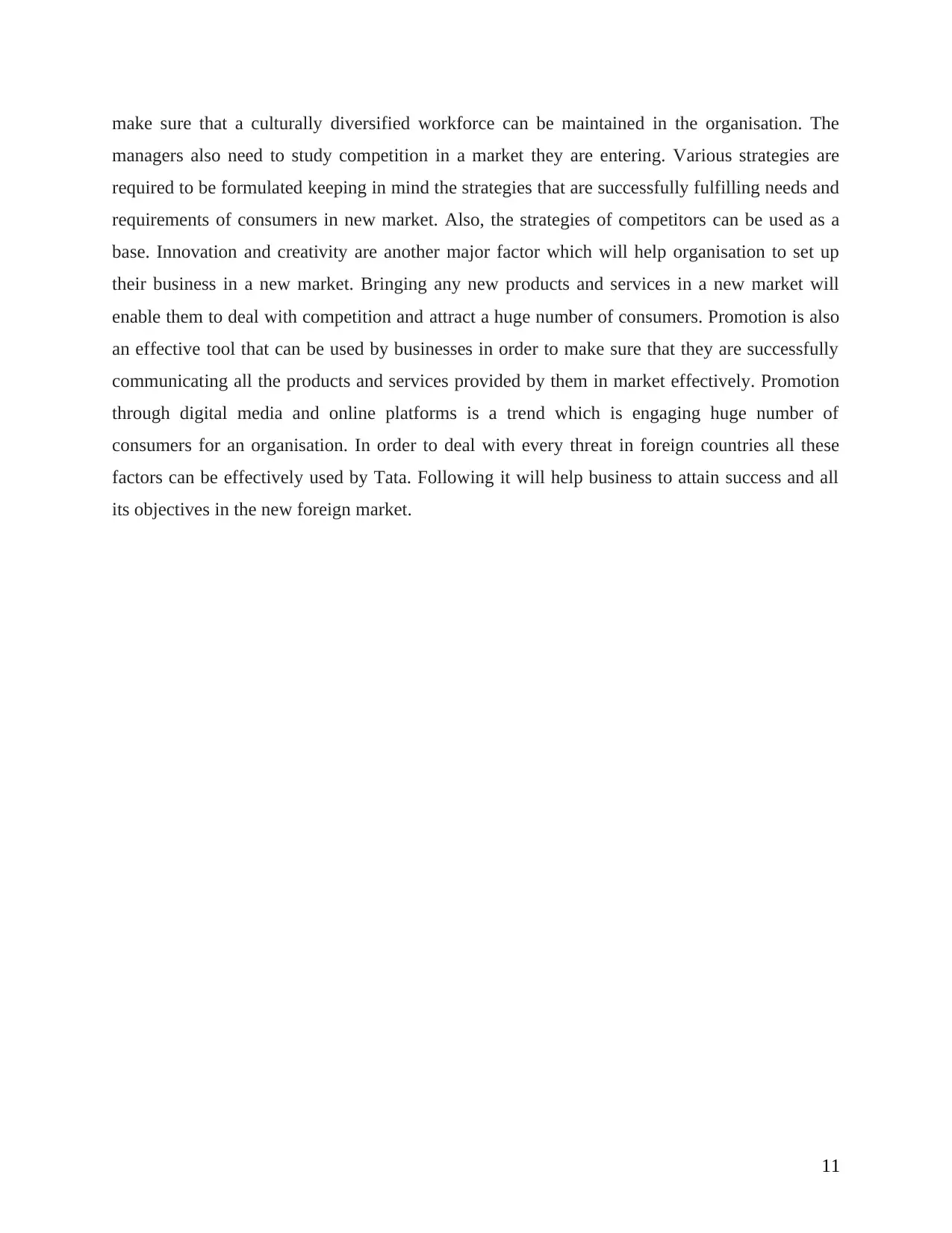
make sure that a culturally diversified workforce can be maintained in the organisation. The
managers also need to study competition in a market they are entering. Various strategies are
required to be formulated keeping in mind the strategies that are successfully fulfilling needs and
requirements of consumers in new market. Also, the strategies of competitors can be used as a
base. Innovation and creativity are another major factor which will help organisation to set up
their business in a new market. Bringing any new products and services in a new market will
enable them to deal with competition and attract a huge number of consumers. Promotion is also
an effective tool that can be used by businesses in order to make sure that they are successfully
communicating all the products and services provided by them in market effectively. Promotion
through digital media and online platforms is a trend which is engaging huge number of
consumers for an organisation. In order to deal with every threat in foreign countries all these
factors can be effectively used by Tata. Following it will help business to attain success and all
its objectives in the new foreign market.
11
managers also need to study competition in a market they are entering. Various strategies are
required to be formulated keeping in mind the strategies that are successfully fulfilling needs and
requirements of consumers in new market. Also, the strategies of competitors can be used as a
base. Innovation and creativity are another major factor which will help organisation to set up
their business in a new market. Bringing any new products and services in a new market will
enable them to deal with competition and attract a huge number of consumers. Promotion is also
an effective tool that can be used by businesses in order to make sure that they are successfully
communicating all the products and services provided by them in market effectively. Promotion
through digital media and online platforms is a trend which is engaging huge number of
consumers for an organisation. In order to deal with every threat in foreign countries all these
factors can be effectively used by Tata. Following it will help business to attain success and all
its objectives in the new foreign market.
11
⊘ This is a preview!⊘
Do you want full access?
Subscribe today to unlock all pages.

Trusted by 1+ million students worldwide
1 out of 13
Related Documents
Your All-in-One AI-Powered Toolkit for Academic Success.
+13062052269
info@desklib.com
Available 24*7 on WhatsApp / Email
![[object Object]](/_next/static/media/star-bottom.7253800d.svg)
Unlock your academic potential
Copyright © 2020–2025 A2Z Services. All Rights Reserved. Developed and managed by ZUCOL.





